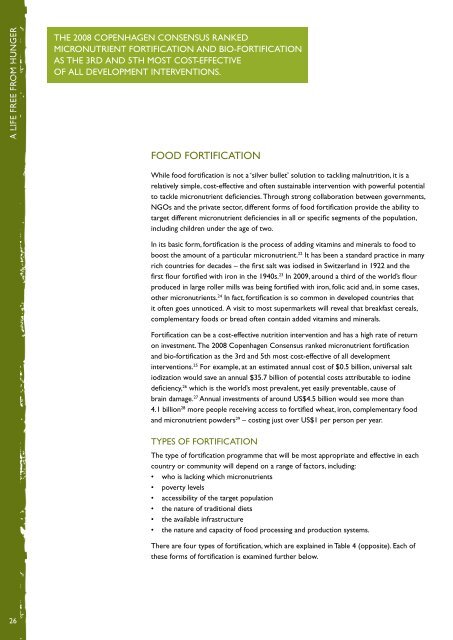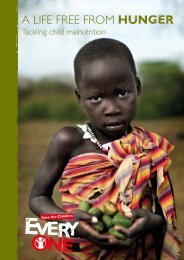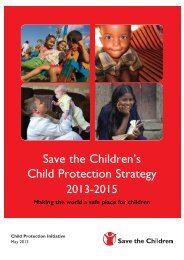NGER A LIFE FREE FROM HUNGER - Save the Children
NGER A LIFE FREE FROM HUNGER - Save the Children
NGER A LIFE FREE FROM HUNGER - Save the Children
Create successful ePaper yourself
Turn your PDF publications into a flip-book with our unique Google optimized e-Paper software.
a life free from hunger<br />
THE 2008 COPENHAGEN CONSENSUS RANKED<br />
MICRONUTRIENT FORTIFICATION AND BIO-FORTIFICATION<br />
AS THE 3RD AND 5TH MOST COST-EFFECTIVE<br />
OF ALL DEVELOPMENT INTERVENTIONS.<br />
FOOD FORTIFICATION<br />
While food fortification is not a ‘silver bullet’ solution to tackling malnutrition, it is a<br />
relatively simple, cost-effective and often sustainable intervention with powerful potential<br />
to tackle micronutrient deficiencies. Through strong collaboration between governments,<br />
NGOs and <strong>the</strong> private sector, different forms of food fortification provide <strong>the</strong> ability to<br />
target different micronutrient deficiencies in all or specific segments of <strong>the</strong> population,<br />
including children under <strong>the</strong> age of two.<br />
In its basic form, fortification is <strong>the</strong> process of adding vitamins and minerals to food to<br />
boost <strong>the</strong> amount of a particular micronutrient. 22 It has been a standard practice in many<br />
rich countries for decades – <strong>the</strong> first salt was iodised in Switzerland in 1922 and <strong>the</strong><br />
first flour fortified with iron in <strong>the</strong> 1940s. 23 In 2009, around a third of <strong>the</strong> world’s flour<br />
produced in large roller mills was being fortified with iron, folic acid and, in some cases,<br />
o<strong>the</strong>r micronutrients. 24 In fact, fortification is so common in developed countries that<br />
it often goes unnoticed. A visit to most supermarkets will reveal that breakfast cereals,<br />
complementary foods or bread often contain added vitamins and minerals.<br />
Fortification can be a cost-effective nutrition intervention and has a high rate of return<br />
on investment. The 2008 Copenhagen Consensus ranked micronutrient fortification<br />
and bio-fortification as <strong>the</strong> 3rd and 5th most cost-effective of all development<br />
interventions. 25 For example, at an estimated annual cost of $0.5 billion, universal salt<br />
iodization would save an annual $35.7 billion of potential costs attributable to iodine<br />
deficiency, 26 which is <strong>the</strong> world’s most prevalent, yet easily preventable, cause of<br />
brain damage. 27 Annual investments of around US$4.5 billion would see more than<br />
4.1 billion 28 more people receiving access to fortified wheat, iron, complementary food<br />
and micronutrient powders 29 – costing just over US$1 per person per year.<br />
TYPES OF FORTIFICATION<br />
The type of fortification programme that will be most appropriate and effective in each<br />
country or community will depend on a range of factors, including:<br />
• who is lacking which micronutrients<br />
• poverty levels<br />
• accessibility of <strong>the</strong> target population<br />
• <strong>the</strong> nature of traditional diets<br />
• <strong>the</strong> available infrastructure<br />
• <strong>the</strong> nature and capacity of food processing and production systems.<br />
There are four types of fortification, which are explained in Table 4 (opposite). Each of<br />
<strong>the</strong>se forms of fortification is examined fur<strong>the</strong>r below.<br />
26
















